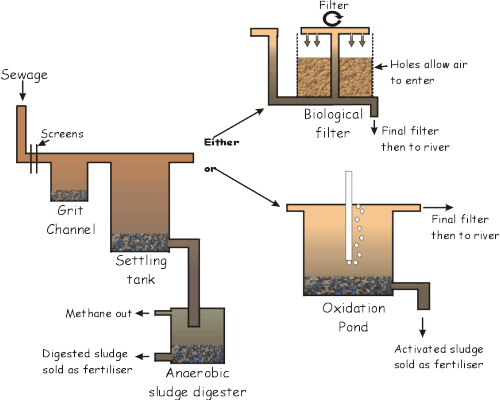Water Pollution
The rivers during the industrial revolution and beyond have suffered greatly from pollution from a number of sources. These problems still continue.
Sewage
Effluent from homes if put directly into rivers will cause a lot of problems. The material in sewage is broken down by bacteria. To do this they need lots of oxygen. As the bacteria feed on the sewage the river is robbed of all its oxygen. As a result the river life dies due to suffocation.
Sewage Treatment
Sewage is more than 99% water and comprises all the liquid waste removed from toilets, wash- basins and kitchen sinks along with industrial and agricultural waste. There are many diseases which are spread by sewage eg:- typhoid, cholera and dysentery. Sewage needs treating before it is put into rivers, to remove harmful organisms and organic matter such as faeces, leaves, paper and rags. If sewage is put into the water ways untreated then the decomposer bacteria will break it down. Decomposition requires oxygen and so large amounts of it will be taken out of the river water leaving the organisms in the river to be staved of oxygen. Sewage treatment aims to remove disease causing organisms and decompose organic material. The diagram below shows the different stages of sewage treatment.

- Screening. Sewage is passed through grids to remove large soluble objects eg:- nappies.
- Grit Settlement. Liquid sewage is passed along a narrow open channel. Heavy objects like grit will settle out.
- Settling Tank. Liquid is left to stand. This allows the suspended solids to settle out to form sludge.
- Sludge Digestion. Settled sludge is allowed to stand in huge tanks which are not aerated. Anaerobic bacteria digest the sludge to produce:- (a) methane gas, used to drive pumps in the works; (b) digested sludge, sold as fertilizer.
- Biological Filter (older sewage works). Liquid is spread over beds of coke by rotating arms. Perforated sides of the filter and the gaps between the coke allow air to enter to encourage aerobic respiration. Decomposers (bacteria and fungi) break down remaining organic material. Protozoa, round worms and insect larvae consume the disease causing organisms (pathogens). The remaining effluent is now clean enough to be passed into a river.
- Oxidation Ponds (newer sewage works). Liquid is pumped into a large thoroughly aerated ponds, to encourage aerobic bacteria and protozoa. Aerobic bacteria flourish, decomposing organic wastes to carbon dioxide faster biological filters. Protozoa consume pathogens. Remaining organic material, than settles out as activated sludge.The activated sludge is sold as fertilizer.
- Humus. The liquid from stage 5 passes into settling tanks so that any humus can settle out.
- Sludge Drying. Sludge is dried out before sale.
Industrial Effluent
Chemicals which are waste products from manufacturing can pollute the water ways. Some of these may not kill organisms straight away, but build up in their bodies, slowly poisoning them.
Farms
Farmers spray various chemicals onto crops to increase their yield. Fertilizers contain nitrates which can be harmful to people. It also leads to eutrophication. This occurs when microscopic algae in rivers and lakes grow out of control due to the high levels of nitrates which are usually in short supply. The growth is so extensive that often a thick slimy coavering to the water is produced and this cuts of light to the plants under the water's surface. As a result they die and the oxygen levels drop. This causes all other life forms in the river or lake to die.
Pesticides are poisons which are obviously harmful. These chemicals which when sprayed on fields can leak into rivers polluting them and the possible water supply for people.
